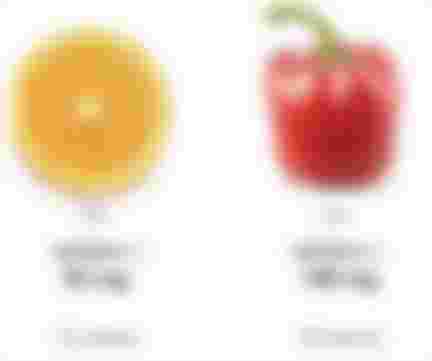A Veggie That's a Fruit? With More Vitamin C Than an Orange?
Vitamin C has always been vital to immune function, but COVID-19 has shone the spotlight on the vitamin in a big way. While everyone is scurrying to stock up on citrus fruits, there's actually another fruit that contains more vitamin C than any other: red bell peppers.

Yes, you read that right. Red bell peppers are often categorized, and cooked, as a vegetable, but because they contain seeds, they're botanically classified as a fruit. Of course, you might not be as concerned with that as much as how they can contribute to your vitamin C intake and what other health benefits red bell peppers have to offer.
Vitamin C in Red Bell Peppers
Although you might immediately think of oranges or orange juice when you hear the term "vitamin C," bell peppers — specifically sweet red bell peppers — are a far better source.
One cup of sliced raw red bell pepper contains 117 milligrams (mg) of vitamin C,1 which actually exceeds the current RDA for the entire day. For comparison, the same amount of green bell peppers contains around 74 mg. According to a comparative study in the September 2012 issue of the Journal of the Science of Food and Agriculture, those numbers increase even more if you choose organic bell peppers.
The researchers analyzed the amounts of bioactive compounds in organically grown bell peppers and conventionally grown bell peppers and found that the organically grown peppers contained significantly more vitamin C and higher amounts of carotenoids, like beta carotene, phenolic acids and flavonoids, such as quercetin.
Health Benefits of Red Bell Peppers
Many of the health benefits of red bell peppers can be attributed to the combination of bioactive compounds found within them. A single red bell pepper contains 30 different antioxidants, making them one of the most nutrient-dense fruits you can eat.

Antioxidants have been shown to help fight heart disease,prevent cancer, protect against liver disease and combat oxidative stress and inflammation. One of the notable compounds in red bell peppers is quercetin, which is known to have a wide range of health benefits. Quercetin has been shown to help reduce inflammation, alleviate pain, lower blood pressure and improve learning and memory.
Of course, some of the health benefits of red bell peppers are also a result of its high vitamin C content. Although vitamin C is often hailed for its powerful immune-boosting properties, it has a protective effect against heart disease and early death, too.
Researchers who published a study in The American Journal of Clinical Nutrition in June 2015 looked at the diet and health of 97,203 people. They found those who consumed the largest amount of fruits and vegetables had a lower risk of developing heart disease and lower risk of early death when compared with those with the lowest intakes.
The researchers concluded that this benefit may be driven by the high vitamin C concentration in fruits and vegetables, since those with the highest plasma vitamin C levels seemed to experience the greatest effect.
Vitamin C has also been linked to better eye health. Oxidative stress is connected to age-related macular degeneration (AMD) and cataracts, two of the leading causes of blindness in older adults.
In one cohort study published in the Journal of the American Medical Association in December 2005, researchers found that a high intake of vitamin C, combined with an above average intake of beta-carotene, vitamin E and zinc, could reduce the risk of developing AMD by 35%.
Vitamin C is also heavily involved in your nervous system. It supports your neurons, modulates the transmission of nerve impulses and helps your body make catecholamines or the hormones dopamine, norepinephrine and epinephrine that help control your stress levels.
How Much Vitamin C Do You Need?
Vitamin C is water-soluble, which means it dissolves in water and is carried throughout the body to your cells for immediate use. Your cells take what they need and anything left over gets excreted from your body through your urine. Unlike fat-soluble vitamins, your body doesn't store any extra for later. Your body also can't make vitamin C on its own. That means it's extra important that you get sufficient amounts from your diet every day.
The current recommendation for vitamin C is 75 mg per day for adult women and 90 mg per day for adult men. While daily doses of several hundred mg per day makes sense for many, there's evidence that higher doses, meaning those over 1,000 mg per day, may be better for combating viruses like the common cold and Epstein-Barr and as part of the treatment for cancer.
Other Sources of Vitamin C
One cup of sliced red bell peppers provides more than the current RDA for vitamin C, but if you want to increase your intake even more, there are plenty of other fruits and vegetables that are excellent sources of vitamin C as well.

One of the most vitamin C-rich fruits available is the acerola or Barbados cherry,22 which provides 1,644 mg of vitamin C per cup.23 Compare that to a medium orange, which contains about 69.7 mg of vitamin C. Other fruits and vegetables that are particularly rich in the vitamin include:
Broccoli
Sweet potato
Grapefruit
Tomato
Cauliflower
Kale
Chili peppers
Papaya
Cantaloupe
Brussels sprouts
Tomato/tomato juice
Kiwifruit
Artichoke
Strawberries
Cooked cabbage
Vitamin C Supplements
Supplementation is an option too, but it's best to get what you need from a variety of fruits and vegetables. When you eat fruits and vegetables, you're not only getting natural, easily absorbed vitamin C, you're also getting dozens of other super nutrients, like antioxidants and phytochemicals, which help fight chronic disease, reduce inflammation and help eliminate carcinogens.
However, if you're having trouble meeting your needs with diet alone, you can supplement a healthy diet with liposomal vitamin C, which has enhanced bioavailability when compared to other oral forms of the vitamin.


